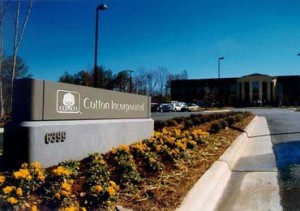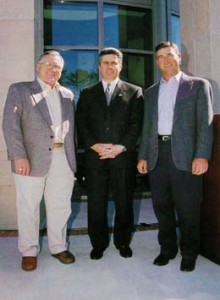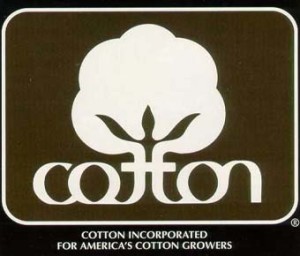By Kelly Padgett

Photo by John Johnson
Cotton Incorporated (CI) is plowing new ground near Raleigh, NC, with a new World Headquarters building comprising more than 125,000 square feet of office and research space. For the first time, almost all of CI’s research and marketing divisions are under one roof. Cary, a suburb of Raleigh, was the site chosen for the new facility to consolidate the divisions and avoid repeated flooding that plagued the older, primary facility in Raleigh.
Hurricane Fran in 1996 resulted in the third natural flooding of the building in 20 years and caused $750,000 in damage. Brad Robb, assistant director of communications at the Cotton Board, said the damage was not a complete loss, but a change in office location became necessary.
Prior to the move, two separate locations existed in Raleigh for such departments as Fiber Quality, Fabric Development, Dyeing and Finishing, Nonwovens, Textile Chemistry, Corporate Development, International Marketing and Agriculture Research. Robb said talks of moving and consolidating the Raleigh facilities had been initiated prior to Fran.
“Before the flood, there was talk about the need for consolidation of the different department locations,” Robb said. Improved efficiency was one significant factor in the decision to unite the various areas of research. Now, 110 of CI’s 160 employees are stationed in Cary. The Cotton Board’s Vice President of Communications, David Fraser, said Fran was the final, motivating factor.

L-R: PCCA Chairman Jackie Mull, CI President and CEO Berrye Worsham and cotton producer Perry Mull. Photo by John Johnson
“Prior to the last flood, it was recognized we had reached the limitations of that facility with regard to the scope of research that could be conducted, not to mention lost efficiency resulting from the commute between the two locations for necessary communication between researchers in two facilities,” Fraser said.
In addition to the consolidation of research and marketing departments, CI’s new World Headquarters, which was built under budget and completed on schedule, is expected to result in savings of as much as $900,000 annually. One significant reason for the savings is that CI’s New York office space was reduced when approximately one-third of the positions there were relocated to Cary. Previously the site of CI’s headquarters, the New York office location was renamed the Consumer Marketing Headquarters in December 1999.
The only divisions remaining in the New York office are Retail Marketing, Public Relations, Advertising, Fashion Marketing and some administrative positions. Even with the combination of most divisions of CI into a single location, there still is room for expansion, according to Fraser.
“There is room available for future expansion in Cary,” Fraser said. “But, there are no plans for the extra land.” During the early stages of planning for the new building, the Cotton Incorporated staff intentionally kept the plans moderate and eliminated unnecessary costs on lavish features. To help maximize efficiency, CI’s department heads were involved in designing their respective areas.
“It was important that the facility be built specifically for cotton research and promotion, so it was built from the ground up; fixing 30 years of “pet peevs” and making all the appropriate adjustments,” Fraser said. “Cotton Incorporated’s senior staff did it right. Part of doing it right included purposely building a modest office while keeping the bottom line in mind. The growers and apparel importers are what drive the Cotton Board and Cotton Incorporated to continue to improve on their efforts for this industry,” Fraser added.
In 1966, the Cotton Board was created by Congress to administer a research and promotion program. Today, the Cotton Board provides oversight and is a funding body for CI’s research and marketing programs.
Initial responses from producers, apparel importers and others who have toured the new facility since February have been very positive, according to Fraser. The official opening of the new location coincided with the 13th Annual Engineered Fiber Selection® Systems Conference in April. The opening of the new headquarters also has brought about new opportunities for expanded projects at CI.
“The new headquarters is a world showcase for cotton textile technology,” Fraser continued. Equipment manufacturers have provided Cotton Incorporated with new equipment for trials in exchange for broad exposure in the new facility. Fraser said industry leaders and growers, in particular, have been astounded at the scope of CI’s work.
Cotton Incorporated has been in the business of building demand and profitability for U.S. cotton growers and apparel importers since 1970 and continues to strengthen cotton’s market share. Through CI’s research, laboratory analysis, and promotion, cotton’s market share has almost doubled since 1973. At that time, market share was only 34 percent. However, after only three years in existence, Cotton Incorporated’s work already had slowed the rate of cotton’s market share decline. Today, cotton’s market share is a much improved 60 percent.

Photo by John Johnson
One of CI’s initial accomplishments was the introduction of the Seal of Cotton which serves as a reliable and familiar symbol for the cotton industry. Robb said development of the Seal of Cotton was, without a doubt, a key building block for cotton and its current preference by consumers.
The Seal of Cotton is not alone in the category of recognizable cotton marketing tools. The television advertising campaign “The Fabric of our Lives®” also is a symbol of the wide scope and success of CI programs. The commercials, originally launched in 1989, show a variety of merchandise made of 100 percent cotton. A more recent campaign, launched in 1998, focused on increasing cotton awareness in the minds of younger consumers who are not yet loyal to one type of fiber or even cognizant about different fibers.
Throughout CI’s history, many other ag and textile innovations and advances have strengthened the cotton market. For instance, CI, in 1994, developed 100 percent cotton shirts resistant to wrinkles. Robb said the process makes clothes look as wrinkle-free and crisp at the end of the day as they do at the beginning.
EasiFlo™ Cottonseed, a recent CI-funded agriculture research development, provides more efficient handling of whole, fuzzy cottonseed that tends to clump. CI researchers found that coating the seeds with a water and starch solution improved handling, an important feature for the dairy industry.
From CI’s Fiber Management research, a collection of computer software programs called Engineered Fiber Selection® (EFS®) helps relay information on bale selection and warehouse operations. EFS consists of three software programs called MILLNet, QRNet and GINNet and an electronic mailbox for data communication called the CI~EDI™ System. EFS was implemented in the early 1980s by Cotton Incorporated’s Charles H. Chewning, Jr., vice president of Fiber Management Research.
Current and future research endeavors in CI’s Agricultural Research Division include reducing soil erosion, improving water utilization through row spacing and patterns, pesticide resistance, pathogens resistance, self-defoliation and many more significant projects affecting the cotton production process.
Nonwoven markets for such uses as medical, beauty and hygiene also have seen improvements with the addition of the Absorblend™ trademark on the Seal of Cotton. The 100 percent cotton guarantee also gives the nonwovens market a credible selling tool.
The Seal of Cotton, “The Fabric of Our Lives” advertising campaign, EasiFlo Cottonseed and many other cotton apparel developments are among the many breakthroughs and milestones CI has achieved on behalf of U.S. cotton producers and apparel importers.
The building of the new Cotton Incorporated World Headquarters in Cary is the next progression toward increased market share, consumer satisfaction and awareness of cotton. Fraser said the new facility serves as the producers’ and apparel importers’ “symbol of commitment to the future of the cotton industry, where we’ve been, how far we’ve come and where we’re going in the future.”


